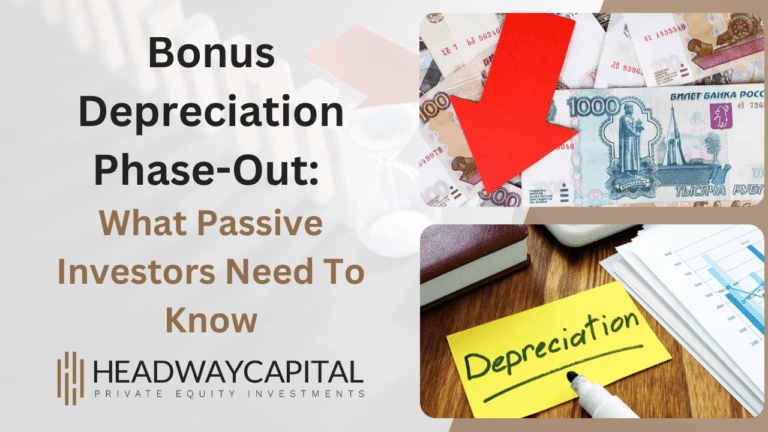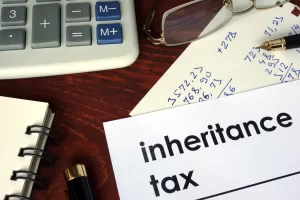In the world of real estate investment, passive investors are constantly seeking opportunities for tax advantages by using bonus depreciation in real estate.
Bonus depreciation in real estate is a tax policy that allows investors to deduct a significant portion of the cost of a property in the year it is placed into service.
However, recent changes to the tax code have brought about a phase-out of this valuable benefit.
In this article, we will discuss what passive multifamily investors need to know about bonus depreciation, the key changes in the bonus depreciation phase out, and provide a brief overview of how bonus depreciation works and its impact on passive investors.
Understanding Bonus Depreciation In Real Estate: A Brief Overview
For passive investors who may be unfamiliar with bonus depreciation, a brief overview can provide clarity.
Bonus depreciation in real estate is an additional depreciation allowance that allows investors to deduct a larger portion of the cost of qualified property in the year it is placed in service. This can be particularly advantageous for investors looking to maximize their tax benefits and improve their cash flow.
Qualified property typically includes tangible property with a recovery period of 20 years or less, such as buildings and improvements. This means that assets like office buildings, retail spaces, and even certain types of equipment can qualify for bonus depreciation. By taking advantage of this provision, investors can accelerate their tax deductions and potentially reduce their overall tax liability.
Under the previous tax law, the bonus depreciation rate was set at 50% for qualified property placed in service after 2007 and before 2018. This meant that investors could deduct half of the cost of qualified property in the year it was placed into service, with the remaining balance depreciated over the asset’s useful life. However, the Tax Cuts and Jobs Act (TCJA) introduced significant changes to bonus depreciation.
The TCJA increased the bonus depreciation rate to 100% for qualified property placed in service after September 27, 2017. This provided a significant tax advantage for investors, allowing them to deduct the entire cost of qualified property in the year it was placed into service. This change was designed to stimulate business investment and provide immediate tax relief, encouraging companies to invest in new equipment and other qualified assets.
By allowing investors to deduct the full cost of qualified property in the year it is placed in service, bonus depreciation can have a positive impact on cash flow. This is especially beneficial for businesses that rely on expensive equipment or have significant capital expenditures. It allows them to free up cash that can be reinvested in the business, used to pay down debt, or distributed to shareholders.
It is important to note that bonus depreciation is subject to certain limitations and requirements. For example, the property must have a recovery period of 20 years or less, and it must be used in a trade or business. Additionally, the property must be new, meaning it cannot be used or previously owned. These requirements ensure that bonus depreciation is targeted toward encouraging new investments and stimulating economic growth.
In conclusion, bonus depreciation is a valuable tax provision that allows investors to deduct a larger portion of the cost of qualified property in the year it is placed in service. By taking advantage of this provision, investors can accelerate their tax deductions, improve cash flow, and potentially reduce their overall tax liability. It is important for investors to consult with a tax professional to fully understand the eligibility requirements and potential benefits of bonus depreciation.
What Passive Multifamily Investors Need To Know About Bonus Depreciation In Real Estate
Passive multifamily investors can greatly benefit from bonus depreciation. This tax incentive allows investors to accelerate the depreciation deductions on their multifamily properties, resulting in potentially significant tax savings.
Traditionally, depreciation deductions have been spread over several years, but with bonus depreciation, investors can take a larger deduction upfront, reducing their taxable income and potentially increasing their cash flow. It’s important for passive investors to understand how this tax advantage works and its potential impact on their investment strategy.
Let’s dive deeper into the mechanics of bonus depreciation. Under the Tax Cuts and Jobs Act (TCJA) passed in 2017, bonus depreciation allows investors to deduct 100% of the cost of eligible property in the year it is placed in service. This means that if you purchase a multifamily property and put it into service in the same year, you can deduct the entire cost of the property as a depreciation expense. This can result in significant tax savings, especially for investors in higher tax brackets.
However, it’s important to note that bonus depreciation is not available for all types of property. To qualify, the property must have a recovery period of 20 years or less. This includes items such as appliances, furniture, carpeting, and certain improvements made to the property. Land and buildings themselves do not qualify for bonus depreciation. It’s crucial for passive investors to work closely with their tax advisors to determine which assets are eligible for bonus depreciation and how to maximize the tax benefits.
Another key aspect to consider is the impact of bonus depreciation on the future sale of the property. While bonus depreciation can provide immediate tax savings, it reduces the basis of the property. This means that when the property is sold, the investor may have a larger taxable gain. However, the potential tax savings from bonus depreciation during the holding period can outweigh the increased tax liability upon sale. Again, consulting with a tax professional is essential to fully understand the long-term implications of utilizing bonus depreciation.
In conclusion, bonus depreciation is a powerful tax incentive that can significantly benefit passive multifamily investors. By accelerating depreciation deductions, investors can reduce their taxable income and potentially increase their cash flow. However, it’s crucial to carefully navigate the eligibility requirements and consider the long-term implications. With the right guidance and understanding, passive investors can leverage bonus depreciation to optimize their investment strategy and maximize their returns.
Key Changes in the Bonus Depreciation Phase Out
Although bonus depreciation in real estate has been a valuable tax benefit for multifamily investors, recent changes in the tax code have introduced a phase-out period.
The Tax Cuts and Jobs Act (TCJA), passed in 2017, allowed for 100% bonus depreciation for qualified property placed in service after September 27, 2017. This provision was a boon for investors, providing them with significant tax savings and encouraging investment in the multifamily sector.
However, starting in 2023, the bonus depreciation percentage will begin to phase out by 20% annually until it reaches 0% in 2027. This gradual reduction in bonus depreciation deductions will impact investors’ tax planning strategies and require them to reassess their investment decisions. As the phase-out period approaches, it becomes crucial for passive investors to stay informed about these changes and consult with their tax advisors to ensure they are maximizing the available tax benefits.
Here is the phase-out schedule:
- 2023: Deduction decreases to 80%
- 2024: 60%
- 2025: 40%
- 2026: 20%
- After 2026: Bonus depreciation is currently set to expire unless new legislation extends it.
One key aspect that investors need to consider is the timing of their property acquisitions. With the bonus depreciation phase-out, it may be advantageous for investors to accelerate their property purchases before the reduction takes effect.
By doing so, they can take advantage of the higher bonus depreciation percentage and maximize their tax savings. This strategic timing can make a significant difference in the overall financial performance of their multifamily properties.
Additionally, understanding when the phase-out will affect their deductions allows investors to plan ahead and make informed decisions regarding their multifamily properties.
They can evaluate the potential impact on their cash flow, tax liability, and overall investment returns. By proactively adjusting their investment strategies, investors can position themselves to mitigate the effects of the bonus depreciation phase-out and optimize their after-tax returns.
Moreover, it’s worth noting that the bonus depreciation phase-out is not the only tax consideration for multifamily investors. There are various other tax incentives and deductions available, such as the Low-Income Housing Tax Credit (LIHTC) and energy-efficient property deductions, that can further enhance the tax benefits associated with multifamily investments. Therefore, investors should work closely with their tax advisors to explore all available options and develop a comprehensive tax strategy that aligns with their investment goals.
In conclusion, the phase-out of bonus depreciation presents multifamily investors with a new set of challenges and considerations.
Staying informed, consulting with tax advisors, and strategically planning their property acquisitions and investment decisions will be crucial for investors to navigate these changes successfully. By doing so, investors can continue to maximize their tax benefits and optimize their returns in the multifamily sector.
The Impact of Bonus Depreciation on Passive Investors
The impact of bonus depreciation on passive investors is substantial.
By taking advantage of this tax benefit, investors can potentially save thousands of dollars in taxes. The ability to deduct a significant portion of the property’s cost in the first year can greatly improve cash flow and overall return on investment.
For passive investors looking to maximize their tax benefits, it’s crucial to consider the timing of their property acquisitions.
Placing a property in service before the phase-out period begins can ensure they can still benefit from the full 100% bonus depreciation deduction. Additionally, understanding the different tax strategies and implications of bonus depreciation can help investors make informed decisions that align with their investment goals.
Overall, bonus depreciation is a valuable tax advantage for passive multifamily investors. However, with the phase-out beginning in 2023, investors must be aware of the changes and adapt their tax planning strategies accordingly. By staying informed and working closely with their tax advisors, passive investors can continue to take advantage of this tax incentive and maximize their overall investment returns.
Maximizing Your Investment Strategy
Despite the phase-out, there are still opportunities to make the most of your real estate investments. Here are some strategies:
- Act Now: Considering the diminishing rate of bonus depreciation, acting sooner rather than later could allow you to maximize your tax benefits. Investments made before the next phase-down can secure higher immediate deductions.
- Focus on Eligible Investments: Not all real estate qualifies for bonus depreciation. Focus on asset classes known for eligibility, such as Multifamily real estate (apartments), and car washes.
- Cost Segregation Studies: These studies can help identify and reclassify personal property assets to shorten the depreciation time for taxation purposes, maximizing your tax deductions. All assets purchased at Headway go through a cost segregation study.
- Consult with Tax Professionals: Navigating the complexities of real estate investment taxes, especially with changing laws, requires expertise. Engaging with tax professionals who understand the intricacies of real estate can provide personalized strategies to optimize your investments.
Looking Ahead
The phase-out of bonus depreciation marks a significant change in the landscape of real estate investing. However, change brings opportunity. By understanding these shifts, you can better position your investments for growth, tax efficiency, and resilience.
As expert real estate professionals, our commitment is to guide you through these changes. Our weekly blogs, social media content, and educational webinars are designed to keep you informed and confident in your investment journey.
Now is the time to explore how these changes impact your investment strategy. Schedule a call or apply to invest with us. Let’s navigate the future of real estate investing together, maximizing your cash flow, equity appreciation, and tax benefits.
Remember, in the world of real estate investment, being informed is the key to success. Let’s take this journey together, making the most of every opportunity the market presents.
When you’re ready, there are 2 ways we can help you:
1. Interested in partnering with us as a passive investor? Schedule a call with us here. We’d like to learn more about your unique investment goals.
2. Ready to apply to invest? Fill out our application here. We’ll be in touch shortly after to see if we’re a good fit for you.
** Please note, that investments are for accredited investors only at this time. **









